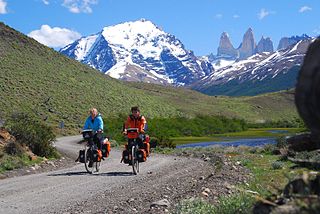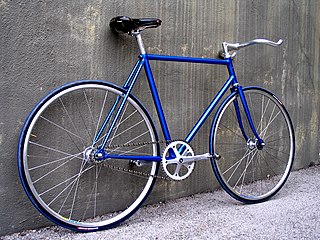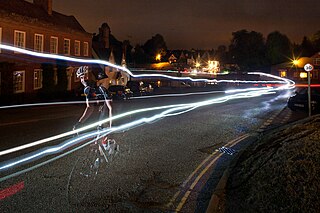
Paris–Brest–Paris (PBP) is a long-distance cycling event. It was originally a 1,200 km (750 mi) bicycle race from Paris to Brest and back to Paris in 1891. The last time it was run as a race was 1951. The most recent edition of PBP was held on 20 August 2023.

Critical Mass is a form of direct action in which people travel as a group on bicycles at a set location and time. The idea is for people to group together to make it safe for each other to ride bicycles through their streets, based on the old adage: there's safety in numbers.

Bicycle touring is the taking of self-contained cycling trips for pleasure, adventure or autonomy rather than sport, commuting or exercise. Bicycle touring can range from single-day trips to extended travels spanning weeks or months. Tours may be planned by the participant or organized by a tourism business, local club or organization, or a charity as a fund-raising venture.

A fixed-gear bicycle is a bicycle that has a drivetrain with no freewheel mechanism such that the pedals always will spin together with the rear wheel. The freewheel was developed early in the history of bicycle design but the fixed-gear bicycle remained the standard track racing design. More recently the "fixie" has become a popular alternative among mainly urban cyclists, offering the advantage of simplicity compared with the standard multi-geared bicycle.

Bicycle culture can refer to a mainstream culture that supports the use of bicycles or to a subculture. Although "bike culture" is often used to refer to various forms of associated fashion, it is erroneous to call fashion in and of itself a culture.

Cycling in Melbourne is an important mode of transport, fitness, sport and recreation in many parts of the city. After a period of significant decline through the mid to late 20th century, additional infrastructure investment, changing transport preferences and increasing congestion has resulted in a resurgence in the popularity of cycling for transport. This is assisted by Melbourne's natural characteristics of relatively flat topography and generally mild climate.

The Dunwich Dynamo is an annual semi-organised, through-the-night bicycle ride from London Fields park in Hackney, London, England to Dunwich on the Suffolk coast. The distance is approximately 112 miles (180 km).

The Marvin Braude Bike Trail is a 22-mile (35 km) paved bicycle path that runs mostly along the shoreline of Santa Monica Bay in Los Angeles County, California. The coastal bike trail is widely acknowledged as Los Angeles’ “most popular bike path.”

The World Naked Bike Ride (WNBR) is an international clothing-optional bike ride in which participants plan, meet and ride together en masse on human-powered transport, to "deliver a vision of a cleaner, safer, body-positive world." The first ride happened in Zaragoza (Spain) in 2001.

The Solstice Cyclists is an artistic, non-political, clothing-optional bike ride celebrating the summer solstice. It is the unofficial start of the Summer Solstice Parade & Pageant, an event produced by the Fremont Arts Council in the Fremont district of Seattle.

An alley cat race is an unsanctioned bicycle race. Alley cats almost always take place in cities, and are often organized by bicycle messengers. The informality of the organization is matched by the emphasis on taking part, rather than simple competition. For instance, many alleycats present prizes for the last competitor to finish.

The Audax Club Parisien (ACP) is a French Cyclist Touring Club. It is a non-profit voluntary association formed in Paris in 1904. It organizes long-distance rides in France. The most popular event is the Paris-Brest-Paris Randonneur, held every four years. The Audax Club Parisien is also the international reference for randonneuring and works with other randonneuring organizations worldwide through the international association Les Randonneurs Mondiaux (LRM).
Positive Pedalers is a non-profit California corporation for people with HIV/AIDS or supporters of people living with HIV/AIDS, which organizes bicycle-related activities.

A spoke card, or spokecard, is a card placed in the spokes of a bicycle wheel. They lie parallel to the entire wheel. Most spoke cards are laminated.
There have been many conflicts during Critical Mass events since the founding of the worldwide bicycling advocacy event in 1992. The conflicts have resulted in injuries, property damage, and arrests, and both bicyclists and motorized vehicle drivers have been victims. Critics say that Critical Mass, held primarily in large metropolitan cities, is a deliberate attempt to obstruct automotive traffic and disrupt normal city functions, when individuals taking part refuse to obey traffic laws, while participants variously consider it a celebration of cycling, of cyclists' rights, and a practical re-imagining of urban space.

Cycling in Los Angeles accounts for less than one percent (0.6%) of all work commutes. Because of the mild climate, there is little need to carry the variety of clothing that cyclists require in other less temperate climates.

Cycling in San Francisco has grown in popularity in recent years, aided by improving cycling infrastructure and community support. San Francisco's compact urban form and mild climate enable cyclists to reach work, shopping, and recreational destinations quickly and comfortably. Though San Francisco's famed steep hills can make cycling difficult, many parts of the city are relatively flat, including some of the most densely populated. However, heavy automobile traffic, the lack of bike lanes on many streets, and difficulty in crossing major streets deter most residents from cycling frequently in San Francisco.

Cycling in Atlanta has grown in popularity in recent years, from 0.33% of commutes in 2000 to 1.1% in 2009, aided by improving cycling infrastructure and community support. Although Atlanta has historically been a city defined by the automobile, its increasingly compact urban form and mild climate are encouraging residents to cycle to work, shopping, and recreational destinations. Though Atlanta's famed hilly topography can make cycling challenging, though fun, many parts of the city are relatively flat, including some of the more densely populated areas. However, heavy automobile traffic, the lack of bike lanes on many streets, and difficulty in crossing major streets deter most residents from cycling frequently in Atlanta.

The Great Victorian Bike Ride, commonly known as The Great Vic, is a non-competitive fully supported eight- or nine-day annual bicycle touring event organised by Bicycle Network. The ride takes different routes around the countryside of the state of Victoria, Australia each year. The total ride distance is usually in the range of 550 kilometres (340 mi), averaging about 70 kilometres (43 mi) a day excluding the rest day. The ride first ran in 1984, attracting 2,100 riders in what was initially supposed to be a one-off event, but due to its unexpected popularity and success it subsequently became an annual event. The Great Vic typically draws several thousand participants each year, with a record of 8,100 riders in 2004, which makes it one of the world's largest supported bicycle rides.
The definition of ultra-distance cycling is far more vague than in ultra running or in ultra-triathlon. Any bike race or ride longer than a century ride, which is 100 miles (160 km), is sometimes considered to be ultra-distance cycling. However, such events are relatively common, so using a longer distance to define the category is more useful, such as any race or ride that is longer than 200 kilometres (120 mi), 300 kilometres (190 mi) or even a double century, 200 miles (320 km).
















